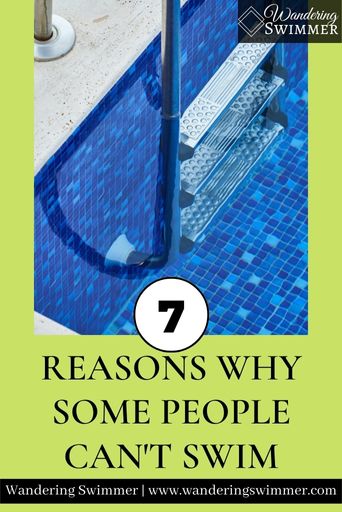When it comes to swimming, it seems like there are two types of people. Those that can swim and those that can’t swim. However, there are several reasons why some people can’t swim and others can.
While some seem simple, others may come as a surprise. We break down 7 reasons why some people can’t swim.
More Content for You: How to Make Swimming Easier
Disclosure: This post may contain affiliate links, meaning we earn a small commission at no cost to you if you purchase something through one of our links. As an Amazon Associate, we earn from qualifying purchases. Please check out our disclosure page for more information.

Lack of Access
Some individuals can’t swim simply due to the lack of access. This can be due to a lack of access to a pool or swim programs in their area.
This lack of access is one of the largest reasons some people can’t swim. And, unfortunately, it’s more common than you realize and not easily fixed.
When the nearest swimming pool or swim school is a distance away from where you live/work, it’s not worth the time and money spent getting there just to learn how to swim or learning how to better the swimming skills you already have.
More Content for You: Basic Swimming Terminology
It’s for this reason that we firmly believe schools should have pools (or access to a pool) and a built-in swimming program as part of their physical education program.
This would help close the gap for communities that don’t have access to a pool and could help lower the percentage of those that can’t swim.
Cost
Next to lack of access, the cost of swimming is another main reason why some people can’t swim. While swimming isn’t the most expensive sport out there, it does cost money.
And even if you focus on leisure and lap swimming compared to competitive swimming, the costs still add up. Getting access to a gym can be expensive and not every gym offers a pool. Some gyms may even charge extra to use the pool in addition to the main workout area.
Gyms also charge additional fees to take swim lessons that are offered at their location. Rarely are they offered free of charge as part of a gym membership. Additionally, classes offered may only focus on children instead of teens and adults.
The cost of swimming isn’t just limited to a facility. It’s also the cost of equipment. Even bare-bone equipment of a swimsuit, cap, and goggles may be more than some people want or can pay.
More Content for You:
- 7 Reasons to Wear Goggles When You Swim
- Your Quick Guide to Swim Caps
- Ultimate Guide for Women’s Swimwear
Lastly, the cost of swimming lessons, in general, isn’t cheap either. Swim schools can cost a significant amount of money per level and cost more for private lessons.
Personal swim instructors through Aqua Mobile or other self-employed instructors may run cheaper. But for some, it’s an expense that they can’t afford.
Fear
The fear of the water (and thereby drowning) is one of the reasons some people can’t swim.
While some people are comfortable around the water, others feel uncomfortable, anxious, or scared when around the water.
Aquaphobia is the fear of water and it can stem from many different reasons or experiences. The severity differs by person and it can develop regardless of age.
More Content for You: Swimming Basics to Get You Started
Typically, if an adult hasn’t learned to swim as a child, they have some fear of swimming. As an adult, it can be more difficult to get over the fear of the water, which makes adults less likely to learn how to swim with every year they age.
Kids have some degree of fear regarding the water and learning how to swim. While they may be excited about it, they may still approach it with trepidation. And others may outright refuse to get in the water due to fear.
Prolonged fear of the water in a child can feed into adulthood, especially if they never learned to swim. It’s why we always recommend swim lessons for kids as not just a way to curb the fear but more so they learn the life-saving benefit of knowing how to swim.
More Content for You: 7 Common Swimming Myths
That said, there are right and wrong ways to overcome the fear of the water.
Don’t ever toss or push someone into the pool or body of water if they have a fear of the water and/or can’t swim. This will only make it worse and could lead to injury/death.
Instead, consult with specialists who deal with phobias to develop a plan that works for you or your child. They’re best qualified to help individuals work through these fears in a healthy and safe manner.
You should also work with an experienced swim instructor to help guide you along the way. Be honest with your fears of the water so they know what to expect.
Bad Swimming Technique
It’s no secret that swimming is hard. Part of what makes swimming so hard is the technical aspect of it. Without a good understanding of the stroke and the correct movements, it can make swimming difficult for some people.
This is why, even though many people don’t realize it, bad swimming technique is one of the other reasons why some people can’t swim. And most people don’t realize they have bad technique, to add to the problem!
This can be an ‘easy’ fix by looking for a coach or swimming instructor to offer feedback. But as discussed previously, not everyone can afford that. Additionally, finding someone who has a decent understanding of swimming techniques and is willing to offer advice or feedback isn’t easy either.
More Content for You: 9 Reasons to Use a Water Bottle When You Swim
For most, it’s easier to continue as they’ve always done. Even if it means they can’t really swim or pass a basic swimming test. Because something is better than nothing and even with their struggles, it’s better than not being able to swim at all.
If you believe this is something you struggle with, we encourage you to keep trying but with the help of some resources. Watching some online tutorials can’t replace an instructor but it can provide guidance. This is especially true if someone can watch or record your swimming.
We also have some technique articles for the various swimming strokes to help get you started. And also provide you with far more information than you needed to know about the strokes themselves!
- Freestyle Technique Articles: Beginner’s Guide to Swimming Freestyle, How to Flutter Kick in Freestyle, and, The Freestyle Stroke and Arm Movement
Consistency
You wouldn’t think it would play a factor in why some people can’t swim, but lack of consistency in the water can play a role.
This is especially true for competitive swimmers but it can impact lap swimmers, too.
Like with most things in life, consistency in swimming is important to help someone swim better. A lot of this stems from the fact that the motions that make up swimming aren’t natural to us.
We don’t hold our breath for stretches of time during the day. Just as we don’t move our arms and legs on land in the same way you would in the water. Because of this, it takes consistency and time to train the muscles in our body to move in this way.
More Content for You: How Many Laps is Considered a Good Swim Workout?
And when it comes down to it, not everyone can make it to the pool consistently. This is especially true if you only have access to an outdoor pool that can’t be used for months at a time due to weather.
Whether it’s the months at a time without being in the water or only getting into the pool on infrequent occasions, the long breaks between swimming sessions can make it difficult for some people.
It’s hard to keep your technique correct, hard to stay in ‘swimming shape’, and hard to remember what you last learned. The inconsistency can also lend to a lack of motivation, which further decreases the time spent in the pool.
Those individuals that don’t stay consistent in their swimming, may struggle to swim whenever they get back into the water. It takes time to get the feeling of the swimming stroke back. And by the time you have it back, you’re already done with your workout or session.
Not Enough Time
This falls in line with the previous reason why some people can’t swim. Consistency and time go hand in hand but are two different reasons.
Our definition is that consistency is more of how often and frequently someone can be in the water. Lack of time focuses more on how much time they have to swim.
At best, we suggest a minimum of thirty minutes in the water for any swimming workout. And of course, it should be at least several times a week to help the technique stick and achieve any goals you’ve set for yourself.
But for some people, even 30 minutes a day or every other day is time they don’t have to give. And we get it. Life is incredibly busy
While 30 minutes of swimming doesn’t seem like a lot, you also have to factor in the time getting to and from the pool. Along with the time spent after, such as showering, laundry, etc.
More Content for You: The 7 Best Swim Shampoos to Remove Chlorine
Add all that into an already busy day of work (or school), taking care of the family, doing chores, and running around, and it’s no wonder even 30 minutes of working out sounds exhausting. It’s far more tempting to spend the time relaxing instead.
And again, we 100% get it. Carving out time in your life for your own personal development and relaxation can be hard.
For those that don’t have enough time in the day or even week, knowing how to swim isn’t a priority for themselves. We do, however, recommend trying to find some time to wedge in learning how to swim if you can.
Mainly because learning to swim is a life-saving benefit and it’s a great way to invest in yourself for a short while 🙂
Mental
I think we can all agree that mental blocks or thoughts can be powerful things. And for some, the mental convincing that they can’t swim is the very reason they can’t swim! Others may have talked themselves out of it long ago or continually tell themselves it’s not worth it.
Some may also struggle with the mental piece that comes from fear. This fear may not just be of the water itself or drowning but the concern that they may look foolish while trying to swim. Or that they look bad in a swimsuit.
More Content for You: 6 Best Prescription Goggles for Swimming
If you find that you struggle with the mental aspect of swimming and it’s attributing to you not being able to swim, you’re not alone! There can be a lot of mental hurdles to overcome in swimming.
Not just for lap swimmers but also competitive swimmers!
Obviously, competitive swimmers know how to swim but they can still face mental blocks when it comes to certain races, distances, or strokes.
So don’t ever feel that your mental block is just for beginners. It can happen to anyone.
In Closing
Swimming can be challenging and scary for many people. It also takes money, time, patience, and commitment, which not everyone has. These are just a few reasons why some people can’t swim.
And even these reasons aren’t as simple as they sound on paper. They’re multilayered reasons and we can never know the whole story as to why some people can’t swim. Instead, it’s best to give advice or assistance if you can (and if it’s been asked) and try to help when possible.
As always, happy swimming!
Chevron
Bonus Content
Can You Swim with Bad Eyesight?: Can you swim with bad eyesight? Bad eyesight may limit you from many things, but swimming isn’t one of them! Here’s 4 ways to swim with bad vision.
Swimming on Your Period FAQ: Yes, you can swim on your period! From one menstruating swimmer to another, here are some frequently asked questions I get about swimming on your period.

Want to Improve at the Pool?
Join swimmers and swim parents to receive my free newsletter and receive a free Swimming Glossary e-book as a thanks!
Every month you’ll receive tips and coaching to help you find success at the pool.
About

Chevron is a current competitive swimmer with almost 20 years of experience in the pool. And although she fell into the sport by accident in her high school years, she still trains daily and competes throughout the year. She’s committed to providing guidance to all levels of swimmers and believes that everyone should know how to swim.